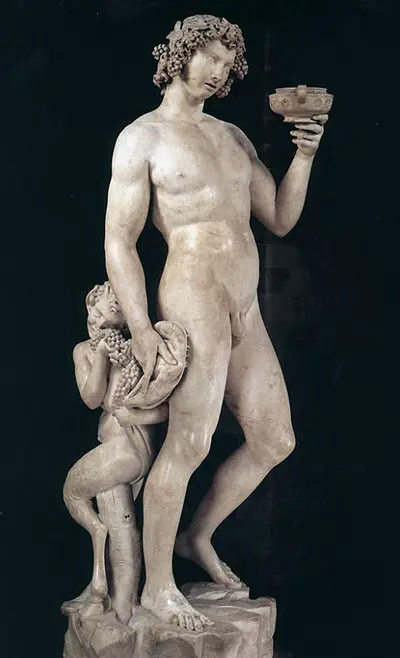Bacchus was created during 1496/1497 as a commission from Raffaele Riario who then rejected the piece. It may be that the high centre of balance on this Bacchus sculpture came across as mocking the Roman God, as it implied drunkenness along with the sculpture's rolling eyes. Whatever the reason for rejecting this piece, it eventually found a home in the garden of Michelangelo's friend Jacopo Galli.
The level of detail on this sculpture is astounding, as with all of Michelangelo's work; it's easy to see why he is considered one of the greatest artists of all time. He created a strong figure but with plump flesh, giving it the sense of androgyny associated with Bacchus, and through his pose the statue seems to almost be in movement even though the eye knows it to be made of stone. The androgyny of the flesh may be another reason why it was rejected, as it may not have seemed respectful to viewers of the time.
Around his head Bacchus wears a wreath of ivy leaves, though many assume they are vine leaves to fit with the theme. In fact, the ivy leaves are there as a tribute to Bacchus himself as the plant is sacred to him.
Some thirty years after the sculpture was finished, Maarten van Heemskerck sketched it in the garden of Jacopo Galli. It is a noteable sketch because by this time Bacchus had lost the hand holding the goblet of wine. The penis had been also chiselled away. It is interesting to have documentation of the state of a sculpture so soon after its creation and see the damage already done to it.
A few historians suggest that the damage was a deliberate attempt to make the statue appear older and grander than it really was, which in modern times seems an unusual motivation as we now know how influential Michelangelo became. However it is worth remembering that at the time the statue was among others that were indeed much older, and it may have stood out. In time, the goblet was added back to the statue, though nothing else was restored.
Around this time, Percy Bysshe Shelley - the poet and husband of the infamous author Mary Shelley - visited the garden with the Bacchus statue. He was not impressed, and said the figure appeared 'drunken, brutal, and narrow-minded'. This was a common opinion of the time although it did nothing to stop Michelangelo's ascent to fame during his lifetime and beyond.
Most artists have to wait until after their death to find any true infamy, but Michelangelo's genius was recognised in his lifetime. Though we now call him one of the greatest artists of all time, he was already considered the greatest artist alive at his own time. He was even referred to as 'Il Divinio' which translates as 'The Divine One', a term which would seem overbearing to an artist today but said a lot about the respect he was given at the time.
Part of this was his ability to bring a sense of awe to the viewer, a wonder that stuck with them for a long time. This is evident in his most famous pieces such as David or the painting in the Sistine Chapel in Rome. It is difficult to see how that links with the sculpture of Bacchus which gained such criticism from noteable parties.
It is tempting, then, to consider this one of his early works and therefore not at the same standard as his others, but this would be a false belief. Bacchus was created around the same time as Pietà, one of his most famous works, and not long before David which is one of the most admired sculptures of any time period.
Perhaps the appeal of Bacchus comes not in its divinity but in its humanness. Though Bacchus was a God, he was a God of very human vices. The sight of a larger-than-life human figure drinking wine and almost swaying right off the rocky outcrop on which he stands may not seem divine, but it is certainly full of feeling and motion that many sculptors never achieve. Though it did not suit sensibilities at the time, Bacchus is the creation of a very talented, visionary artist who made his mark in a way that changed Western art forever.
However, it is not one of the most memorable in our cultural history; perhaps due to its original reputation, or merely due to the fact Michelangelo's other works eclipse even this beauty. In the 1570s the statue was bought by Medici and subsequently transferred to Florence; this affluent banking family had possession of it for some time. It now sits in the Museo Nazionale del Bargello in Florence.
Bacchus from Michelangelo was a sculpture completed around 1497.
This large sculpture stands at over two metres tall, whilst the Greek God himself would not have been quite that size. This interesting representation features the God of Wine seemingly rather the worst for wear, as demonstrated by his sunken pose.
The photograph to the right is of a close-up print which captures the detail which Michelangelo put into this sculpture.
The bowl is his hand is likely to have been some form of drinking vessel from that period, with Bacchus struggling to hold it straight.


